国际经济学第五版第三章答案
国际经济学第三章答案
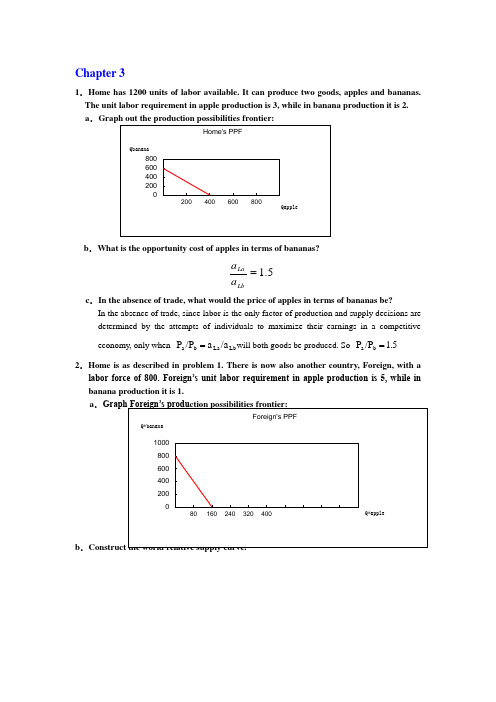
Chapter 31.Home has 1200 units of labor available. It can produce two goods, apples and bananas. The unit labor requirement in apple production is 3, while in banana production it is 2. a .b .What is the opportunity cost of apples in terms of bananas?5.1=LbLa a a c .In the absence of trade, what would the price of apples in terms of bananas be?In the absence of trade, since labor is the only factor of production and supply decisions aredetermined by the attempts of individuals to maximize their earnings in a competitive economy, only when Lb La b a /a a /P P =will both goods be produced. So 1.5 /P P b a =2.Home is as described in problem 1. There is now also another country, Foreign, with alabor force of 800. Foreign’s unit labor requirement in apple production is 5, while in banana production it is 1.a .b .3.Now suppose world relative demand takes the following form: Demand for apples/demand for bananas = price of bananas/price of apples.a .Graph the relative demand curve along with the relative supply curve:a b b a /P P /D D =∵When the market achieves its equilibrium, we have 1b a )(D D -**=++=ba b b a a P P Q Q Q Q ∴RD is a hyperbola xy 1=b .What is the equilibrium relative price of apples?The equilibrium relative price of apples is determined by the intersection of the RD and RScurves.RD: yx 1= RS: 5]5,5.1[5.1],5.0(5.0)5.0,0[=∈=⎪⎩⎪⎨⎧+∞∈=∈y y y x x x ∴25.0==y x∴2/=b P a P e ec .Describe the pattern of trade.∵b a b e a e b a P P P P P P ///>>**∴In this two-country world, Home will specialize in the apple production, export apples and import bananas. Foreign will specialize in the banana production, export bananas and import apples.d .Show that both Home and Foreign gain from trade.International trade allows Home and Foreign to consume anywhere within the coloredlines, which lie outside the countries’ production possibility frontiers. And the indirect method, specializing in producing only one production then trade with other country, is a more efficient method than direct production. In the absence of trade, Home could gain three bananas by foregoing two apples, and Foreign could gain by one foregoing five bananas. Trade allows each country to trade two bananas for one apple. Home could then gain four bananas by foregoing two apples while Foreign could gain one apple by foregoing only two bananas. So both Home and Foreign gain from trade.4.Suppose that instead of 1200 workers, Home had 2400. Find the equilibrium relative price. What can you say about the efficiency of world production and the division of the gains from trade between Home and Foreign in this case? RD: yx 1=RS: 5]5,5.1[5.1],1(1)1,0[=∈=⎪⎩⎪⎨⎧+∞∈=∈y y y x x x ∴5.132==y x∴5.1/=b P a P e eIn this case, Foreign will specialize in the banana production, export bananas and importapples. But Home will produce bananas and apples at the same time. And the opportunity cost of bananas in terms of apples for Home remains the same. So Home neither gains nor loses but Foreign gains from trade.5.Suppose that Home has 2400 workers, but they are only half as production in both industries as we have been assuming, Construct the world relative supply curve and determine the equilibrium relative price. How do the gains from trade compare with those in the case described in problem 4?In this case, the labor is doubled while the productivity of labor is halved, so the "effective labor "remains the same. So the answer is similar to that in 3. And both Home and Foreign can gain from trade. But Foreign gains lesser compare with that in the case4.6.”Korean workers earn only $2.50 an hour; if we allow Korea to export as much as it likes to the United State s, our workers will be forced down to the same level. You can’t import a $5 shirt without importing the $2.50 wage that goes with it.” Discuss.In fact, relative wage rate is determined by comparative productivity and the relative demand for goods. Kore a’s low wage reflects the fact that Korea is less productive than the United States in most industries. Actually, trade with a less productive, low wage country can raise the welfare and standard of living of countries with high productivity, such as United States. So this pauper labor argument is wrong.7.Japanese labor productivity is roughly the same as that of the United States in the manufacturing sector (higher in some industries, lower in others), while the United States, is still considerably more productive in the service sector. But most services are non-traded. Some analysts have argued that this poses a problem for the United States, because our comparative advantage lies in things we cannot sell on world markets. What is wrong with this argument?The competitive advantage of any industry depends on both the relative productivities of the industries and the relative wages across industries. So there are four aspects should be taken into account before we reach conclusion: both the industries and service sectors of Japan and U.S., not just the two service sectors. So this statement does not bade on the reasonable logic. 8.Anyone who has visited Japan knows it is an incredibly expensive place; although Japanese workers earn about the same as their U.S. counterparts, the purchasing power of their incomes is about one-third less. Extend your discussing from question 7 to explain this observation. (Hint: Think about wages and the implied prices of non-trade goods.) The relative higher purchasing power of U.S. is sustained and maintained by its considerably higher productivity in services. Because most of those services are non-traded, Japanese could not benefit from those lower service costs. And U.S. does not have to face a lower international price of services. So the purchasing power of Japanese is just one-third of their U.S. counterparts.9.How does the fact that many goods are non-traded affect the extent of possible gains from trade?Actually the gains from trade depended on the proportion of non-traded goods. The gains will increase as the proportion of non-traded goods decrease.10.We have focused on the case of trade involving only two countries. Suppose that there are many countries capable of producing two goods, and that each country has only one factor of production, labor. What could we say about the pattern of production and in this case? (Hint: Try constructing the world relative supply curve.)Any countries to the left of the intersection of the relative demand and relative supply curves export the good in which they have a comparative advantage relative to any country to the right of the intersection. If the intersection occurs in a horizontal portion then the country with that price ratio produces both goods.。
《国际经济学》课后习题参考答案
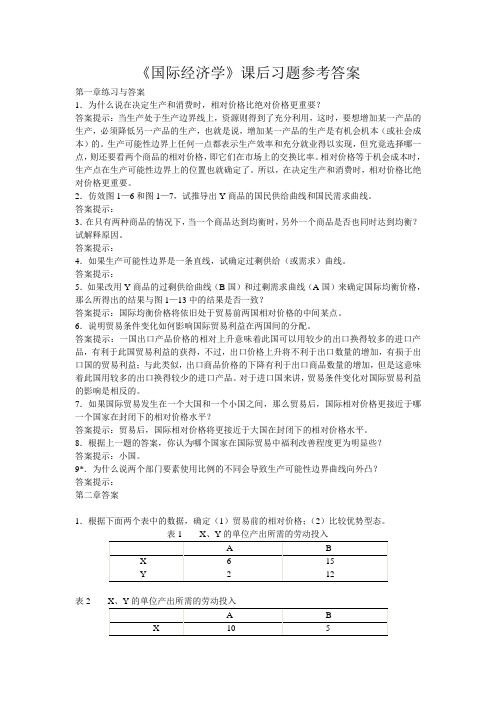
《国际经济学》课后习题参考答案第一章练习与答案1.为什么说在决定生产和消费时,相对价格比绝对价格更重要?答案提示:当生产处于生产边界线上,资源则得到了充分利用,这时,要想增加某一产品的生产,必须降低另一产品的生产,也就是说,增加某一产品的生产是有机会机本(或社会成本)的。
生产可能性边界上任何一点都表示生产效率和充分就业得以实现,但究竟选择哪一点,则还要看两个商品的相对价格,即它们在市场上的交换比率。
相对价格等于机会成本时,生产点在生产可能性边界上的位置也就确定了。
所以,在决定生产和消费时,相对价格比绝对价格更重要。
2.仿效图1—6和图1—7,试推导出Y商品的国民供给曲线和国民需求曲线。
答案提示:3.在只有两种商品的情况下,当一个商品达到均衡时,另外一个商品是否也同时达到均衡?试解释原因。
答案提示:4.如果生产可能性边界是一条直线,试确定过剩供给(或需求)曲线。
答案提示:5.如果改用Y商品的过剩供给曲线(B国)和过剩需求曲线(A国)来确定国际均衡价格,那么所得出的结果与图1—13中的结果是否一致?答案提示:国际均衡价格将依旧处于贸易前两国相对价格的中间某点。
6.说明贸易条件变化如何影响国际贸易利益在两国间的分配。
答案提示:一国出口产品价格的相对上升意味着此国可以用较少的出口换得较多的进口产品,有利于此国贸易利益的获得,不过,出口价格上升将不利于出口数量的增加,有损于出口国的贸易利益;与此类似,出口商品价格的下降有利于出口商品数量的增加,但是这意味着此国用较多的出口换得较少的进口产品。
对于进口国来讲,贸易条件变化对国际贸易利益的影响是相反的。
7.如果国际贸易发生在一个大国和一个小国之间,那么贸易后,国际相对价格更接近于哪一个国家在封闭下的相对价格水平?答案提示:贸易后,国际相对价格将更接近于大国在封闭下的相对价格水平。
8.根据上一题的答案,你认为哪个国家在国际贸易中福利改善程度更为明显些?答案提示:小国。
国际经济学课后答案
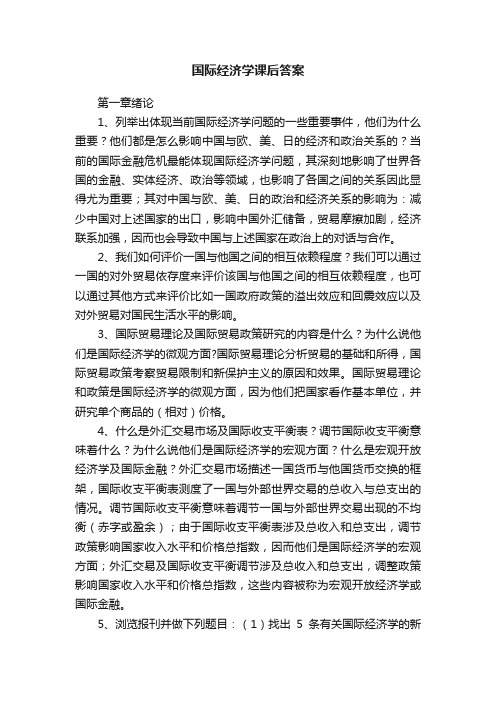
国际经济学课后答案第一章绪论1、列举出体现当前国际经济学问题的一些重要事件,他们为什么重要?他们都是怎么影响中国与欧、美、日的经济和政治关系的?当前的国际金融危机最能体现国际经济学问题,其深刻地影响了世界各国的金融、实体经济、政治等领域,也影响了各国之间的关系因此显得尤为重要;其对中国与欧、美、日的政治和经济关系的影响为:减少中国对上述国家的出口,影响中国外汇储备,贸易摩擦加剧,经济联系加强,因而也会导致中国与上述国家在政治上的对话与合作。
2、我们如何评价一国与他国之间的相互依赖程度?我们可以通过一国的对外贸易依存度来评价该国与他国之间的相互依赖程度,也可以通过其他方式来评价比如一国政府政策的溢出效应和回震效应以及对外贸易对国民生活水平的影响。
3、国际贸易理论及国际贸易政策研究的内容是什么?为什么说他们是国际经济学的微观方面?国际贸易理论分析贸易的基础和所得,国际贸易政策考察贸易限制和新保护主义的原因和效果。
国际贸易理论和政策是国际经济学的微观方面,因为他们把国家看作基本单位,并研究单个商品的(相对)价格。
4、什么是外汇交易市场及国际收支平衡表?调节国际收支平衡意味着什么?为什么说他们是国际经济学的宏观方面?什么是宏观开放经济学及国际金融?外汇交易市场描述一国货币与他国货币交换的框架,国际收支平衡表测度了一国与外部世界交易的总收入与总支出的情况。
调节国际收支平衡意味着调节一国与外部世界交易出现的不均衡(赤字或盈余);由于国际收支平衡表涉及总收入和总支出,调节政策影响国家收入水平和价格总指数,因而他们是国际经济学的宏观方面;外汇交易及国际收支平衡调节涉及总收入和总支出,调整政策影响国家收入水平和价格总指数,这些内容被称为宏观开放经济学或国际金融。
5、浏览报刊并做下列题目:(1)找出5条有关国际经济学的新闻(2)每条新闻对中国经济的重要性或影响(3)每条新闻对你个人有何影响A (1) 国际金融危机: 影响中国整体经济,降低出口、增加失业、经济减速等(2) 美国大选:影响中美未来经济政治关系(3) 石油价格持续下跌:影响中国的能源价格及相关产业(4) 可口可乐收购汇源被商务部否决:《反垄断法》的第一次实施,加强经济法治(5) 各国政府经济刺激方案:对中国经济产生外部性效应B 以上5条新闻对个人影响为:影响个人消费水平和就业前景第二章比较优势理论1、重商主义者的贸易观点如何?他们的国家财富概念与现在有何不同?重商主义者主张政府应当竭尽所能孤立出口,不主张甚至限制商品(尤其是奢侈类消费品)。
国际经济学课后习题答案
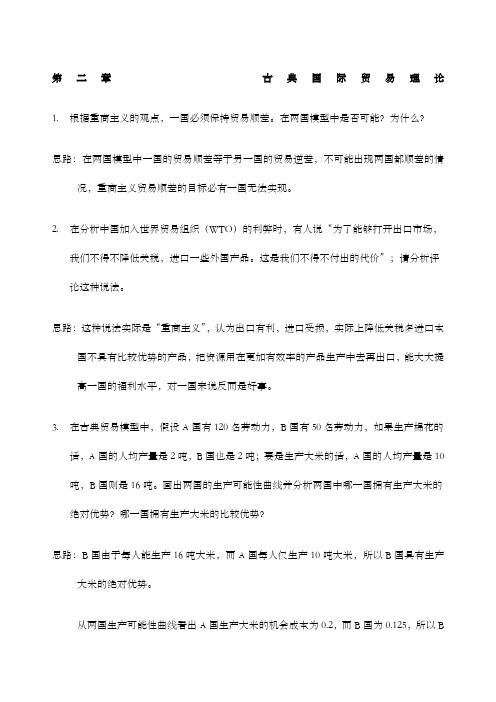
第二章古典国际贸易理论1.根据重商主义的观点,一国必须保持贸易顺差。
在两国模型中是否可能?为什么?思路:在两国模型中一国的贸易顺差等于另一国的贸易逆差,不可能出现两国都顺差的情况,重商主义贸易顺差的目标必有一国无法实现。
2.在分析中国加入世界贸易组织(WTO)的利弊时,有人说“为了能够打开出口市场,我们不得不降低关税,进口一些外国产品。
这是我们不得不付出的代价”;请分析评论这种说法。
思路:这种说法实际是“重商主义”,认为出口有利,进口受损,实际上降低关税多进口本国不具有比较优势的产品,把资源用在更加有效率的产品生产中去再出口,能大大提高一国的福利水平,对一国来说反而是好事。
3.在古典贸易模型中,假设A国有120名劳动力,B国有50名劳动力,如果生产棉花的话,A国的人均产量是2吨,B国也是2吨;要是生产大米的话,A国的人均产量是10吨,B国则是16吨。
画出两国的生产可能性曲线并分析两国中哪一国拥有生产大米的绝对优势?哪一国拥有生产大米的比较优势?思路:B国由于每人能生产16吨大米,而A国每人仅生产10吨大米,所以B国具有生产大米的绝对优势。
从两国生产可能性曲线看出A国生产大米的机会成本为0.2,而B国为0.125,所以B国生产大米的机会成本或相对成本低于A 国,B 国生产大米具有比较优势。
4.理论,决不是个强权理论,只要按照比较优势进行贸易,专业化生产,充分有效地利用资源,穷国也可以得到好处,这不仅可以从Sachs 和Warner 对78个发展中国家贸易与经济发展的关系研究中的得到证实,单从中国改革开放的实践就可以得到说明。
5. 下表列出了加拿大和中国生产1单位计算机和1单位小麦所需的劳动时间。
假定生产计算机和小麦都只用劳动,加拿大的总劳动为600小时,中国总劳动为800小时。
(1) 计算不发生贸易时各国生产计算机的机会成本。
(2) 哪个国家具有生产计算机的比较优势?哪个国家具有生产小麦的比较优势?800 1200(3)如果给定世界价格是1单位计算机交换22单位的小麦,加拿大参与贸易可以从每单位的进口中节省多少劳动时间?中国可以从每单位进口中节省多少劳动时间?如果给定世界价格是1单位计算机交换24单位的小麦,加拿大和中国分别可以从进口每单位的货物中节省多少劳动时间?(4)在自由贸易的情况下,各国应生产什么产品,数量是多少?整个世界的福利水平是提高还是降低了?试用图分析。
国际经济学第三章课后习题答案

2.本国共有1200单位的劳动,能生产两种产品:苹果和香蕉。
苹果的单位产品劳动投入是3,香蕉的单位产品劳动投入是 2.a。
画出本国的生产可能性边界。
b.用香蕉衡量的苹果的机会成本是多少?c.贸易前,苹果对香蕉的相对价格是多少?为什么?a.b.c.在贸易前,当劳动是生产的唯一要素,且在竞争日益激烈的经济环境中,供给决策是由个人获得的最大收益决定时,只有当时,这两种货物才能被生产。
所以,教科书问题的答案1. a。
生产可能性曲线是一条直线,截获苹果轴在400(1200/3)和香蕉轴上600(1200/2)。
b。
机会成本的苹果,香蕉是3/2而言。
它需要3个单位的劳动收获一个苹果,但是只有两个单位的劳动收获一根香蕉。
如果一个人foregoes收获一个苹果,这释放3个单位的劳动。
这3个单位的劳动就能够被用来收获1.5香蕉。
c。
劳动力流动,保证了每一个环节上常见的工资和竞争保证了货物的价格等于他们的生产成本。
因此,相对价格的相对成本相等时,它等于倍的工资单位劳动条件为苹果的工资倍除以单位劳动要求香蕉。
由于工资是平等的交叉,价格比率之比相等单位劳动要求,为苹果每2是3个香蕉。
2,3,6,7,11,14]。
生产可能性曲线是线性的,在苹果和拦截800/5相当于160(轴)和拦截踩在香蕉轴等于800(800/1)。
b。
世界相对供给曲线,建立确定供应苹果相对于供应的香蕉在每个相对价格。
最低的相对价格,比如苹果是收获3苹果每2个香蕉。
供给曲线是平的相对这个价钱。
苹果的最大数量的价格提供3/2在家里是400所提供的同时,以这样的价格,外国的丰收,800香蕉和没有苹果给最大相对供应以这个价格的1 / 2。
这种相对供应价格之间3/2适用任何和五日。
的价格是5,两国将在收成苹果。
供给曲线是又相对平坦的5。
因此,相关的供给曲线是一步成型,公寓,租金价格相对而言3/2供应为0到1 / 2,垂直的,从3/2数量相对半上升到5元,然后再从半无限地来讲一个。
国际经济学理论与政策第三章答案

♦ The opportunity cost of producing roses is the amount of computers not produced.
3-8
2
Comparative Advantage and Opportunity Cost (cont.)
• The US has a lower opportunity cost in producing computers.
♦ Ecuador can produce 30,000 computers, compared to 10 million roses that it could otherwise produce.
Copyright © 2006 Pearson Addison-Wesley. All rights reserved.
3-3
Introduction (cont.)
• The Ricardian model (chapter 3) says differences in productivity of labor between countries cause productive differences, leading to gains from trade.
♦ The US can produce 10 million roses, compared to 100,000 computers that it could otherwise produce.
Copyright © 2006 Pearson Addison-Wesley. All rights reserved.
国际经济学作业答案

第一章练习与答案1.为什么说在决定生产和消费时,相对价格比绝对价格更重要?答案提示:当生产处于生产边界线上,资源则得到了充分利用,这时,要想增加某一产品的生产,必须降低另一产品的生产,也就是说,增加某一产品的生产是有机会机本(或社会成本)的。
生产可能性边界上任何一点都表示生产效率和充分就业得以实现,但究竟选择哪一点,则还要看两个商品的相对价格,即它们在市场上的交换比率。
相对价格等于机会成本时,生产点在生产可能性边界上的位置也就确定了。
所以,在决定生产和消费时,相对价格比绝对价格更重要。
2.仿效图1—6和图1—7,试推导出Y商品的国民供给曲线和国民需求曲线。
答案提示:3.在只有两种商品的情况下,当一个商品达到均衡时,另外一个商品是否也同时达到均衡?试解释原因。
答案提示:4.如果生产可能性边界是一条直线,试确定过剩供给(或需求)曲线。
答案提示:5.如果改用Y商品的过剩供给曲线(B国)和过剩需求曲线(A国)来确定国际均衡价格,那么所得出的结果与图1—13中的结果是否一致?答案提示:国际均衡价格将依旧处于贸易前两国相对价格的中间某点。
6.说明贸易条件变化如何影响国际贸易利益在两国间的分配。
答案提示:一国出口产品价格的相对上升意味着此国可以用较少的出口换得较多的进口产品,有利于此国贸易利益的获得,不过,出口价格上升将不利于出口数量的增加,有损于出口国的贸易利益;与此类似,出口商品价格的下降有利于出口商品数量的增加,但是这意味着此国用较多的出口换得较少的进口产品。
对于进口国来讲,贸易条件变化对国际贸易利益的影响是相反的。
7.如果国际贸易发生在一个大国和一个小国之间,那么贸易后,国际相对价格更接近于哪一个国家在封闭下的相对价格水平?答案提示:贸易后,国际相对价格将更接近于大国在封闭下的相对价格水平。
8.根据上一题的答案,你认为哪个国家在国际贸易中福利改善程度更为明显些?答案提示:小国。
9*.为什么说两个部门要素使用比例的不同会导致生产可能性边界曲线向外凸?答案提示:第二章答案1.根据下面两个表中的数据,确定(1)贸易前的相对价格;(2)比较优势型态。
国际经济学课后题答案修订稿

国际经济学课后题答案集团文件发布号:(9816-UATWW-MWUB-WUNN-INNUL-DQQTY-第3章课后题答案、1、商品的相对要素强度:不同商品的资本/劳动比率的不同,通过比较可判断该商品是资本密集型商品还是劳动力密集型商品。
国家的相对要素丰裕:要素丰裕度是指一国要素拥有的相对状况。
贸易的商品构成:即使技术水平相同,生产要素禀赋不同也可以产生贸易。
一国终将出口密集的使用其相对丰裕(便宜的生产要素)生产的商品,进口那些密集使用其相对稀缺(昂贵的要素)生产的商品。
商品流动和要素流动的相互替代:如果加拿大或者欧洲国家对美国的资本密集型商品设立保护性贸易壁垒,那么,美国企业就可以向这些国家进行投资,建立工厂,在这些国家之内进行生产,绕过贸易壁垒。
(P37)里昂剔夫悖论是否证实了这种解释如果不是,那又是什么里昂惕夫利用计算结果表明得出了与要素禀赋理论完全相悖的结论。
人力资本说、贸易壁垒说、自然资源稀缺说、需求逆转说可以解释这种现象。
2、要素比例理论不是产业内贸易的一个良好的解释。
规模经济理论可以更好的解释。
6、区别产业间贸易与产业内贸易,并分别举例。
请提供有关产业间贸易和产业内贸易的解释。
•产业间贸易:是国家之间完全不同商品的贸易,可以用要素禀赋理论来解释。
•产业内贸易:是国家之间高度相似的商品的贸易,可以用规模经济来解释。
例子:略7、根据垄断竞争和规模经济理论,产业内贸易的利益包括:•对于生产者:规模经济效应,降低了每个种类商品的生产成本•对于消费者:更低的价格和更多的商品种类•生产要素所有者:所有的生产要素都从贸易中获得利益。
第4章课后题答案2:有效保护率是指关税使被保护行业每单位产出的附加值提高的百分率。
a. 对最终商品的有效保护率取决于最终产品的名义税率和投入品的名义税率。
取决于商品国内附加值占商品价格的比例。
为了保护本国的出口企业,提高有效保护率,对进口原材料免税或者低的关税。
b用有效保护率的分析方法解释下列政策问题:发展中国家的生产深化:第一阶段,发展中国家实行保护性的高关税,并对投入品进口免征关税,进而开始建立起总装配厂。
萨尔瓦多国际经济学第三章课后练习题答案

1.在一个坐标系内,画一条凹向原点的生产可能性曲线:(1)从生产可能性曲线的中点开始用箭头表示该国在生产更多X(横轴表示的商品)和更多Y时所发生的机会成本递增情况。
(2)当生产更多的X时,生产可能性曲线的斜率如何变化?生产更多的Y呢?这种变化反映了什么?答:(1)图1 生产可能性曲线(3)如上图所示,当生产更多的X时,生产可能性曲线的斜率变大;当生产更多的Y时,生产可能性曲线的斜率变大。
原因是当该国生产更多的X或Y时,机会成本会变大。
2.在另一个坐标系内,画三条社会无差异曲线,并令最高的两条相交:(1) 社会无差异曲线为什么向下倾斜,或者说斜率为负?(2)曲线的斜率代表什么?为什么每条无差异曲线在较低点斜率较小?(3)考虑相交的两条无差异曲线,是在交点右边的还是在交点左边的曲线表示的满足程度较高?为什么和无差异曲线的定义不一致?你可以得出什么结论?答:图2 社会无差异曲线(1)社会无差异曲线之所以会向下倾斜是因为为了维持社会福利水平不变,随着X商品消费的增加必须减少Y的消费。
(2)曲线的斜率代表一国在保持处在同一条无差异曲线的前提下,多消费一单位x而必须少消费Y的数量。
一国消费X越多,则其消费Y越少。
对该国来说,一单位Y的效用会逐渐增大。
因此,该国每多消费一单位X,只会放弃越来越少的Y商品。
所以,无差异曲线在较低点斜率较小。
(3)无差异曲线的定义表明每条无差异曲线意味着一个给定的满足程度,无差异曲线互不相交。
无差异曲线II显示了比交点右边更高的满足程度,无差异曲线II显示了比交点左边更高的满足程度。
因此,这个图是不合理。
3.在一个坐标系内,画一条生产可能性曲线,再画一条无差异曲线切于生产可能性曲线较平坦的地方,在另一个坐标系内,面另一条生产可能性曲线,再画另一条无差异曲线切于生产可能性曲线较陡直的地方。
(1)画一条表示各国孤立均衡相对价格的直线。
(2)各国具有比较优势的商品分别是什么?(3)在什么(极端)情况下,两国之间不存在比较优势或比较劣势?答:国家1 国家2图3 孤立均衡(1)如图3所示,P A和P A’是两国在孤立均衡情况下的价格。
国际经济学课后习题答案
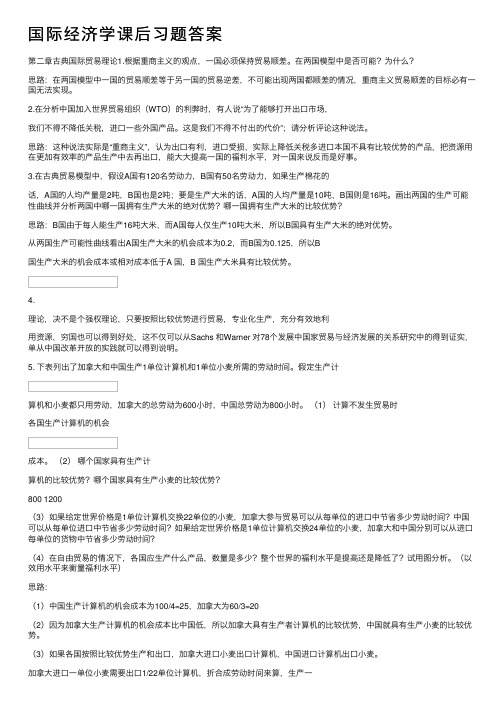
国际经济学课后习题答案第⼆章古典国际贸易理论1.根据重商主义的观点,⼀国必须保持贸易顺差。
在两国模型中是否可能?为什么?思路:在两国模型中⼀国的贸易顺差等于另⼀国的贸易逆差,不可能出现两国都顺差的情况,重商主义贸易顺差的⽬标必有⼀国⽆法实现。
2.在分析中国加⼊世界贸易组织(WTO)的利弊时,有⼈说“为了能够打开出⼝市场,我们不得不降低关税,进⼝⼀些外国产品。
这是我们不得不付出的代价”;请分析评论这种说法。
思路:这种说法实际是“重商主义”,认为出⼝有利,进⼝受损,实际上降低关税多进⼝本国不具有⽐较优势的产品,把资源⽤在更加有效率的产品⽣产中去再出⼝,能⼤⼤提⾼⼀国的福利⽔平,对⼀国来说反⽽是好事。
3.在古典贸易模型中,假设A国有120名劳动⼒,B国有50名劳动⼒,如果⽣产棉花的话,A国的⼈均产量是2吨,B国也是2吨;要是⽣产⼤⽶的话,A国的⼈均产量是10吨,B国则是16吨。
画出两国的⽣产可能性曲线并分析两国中哪⼀国拥有⽣产⼤⽶的绝对优势?哪⼀国拥有⽣产⼤⽶的⽐较优势?思路:B国由于每⼈能⽣产16吨⼤⽶,⽽A国每⼈仅⽣产10吨⼤⽶,所以B国具有⽣产⼤⽶的绝对优势。
从两国⽣产可能性曲线看出A国⽣产⼤⽶的机会成本为0.2,⽽B国为0.125,所以B国⽣产⼤⽶的机会成本或相对成本低于A 国,B 国⽣产⼤⽶具有⽐较优势。
4.理论,决不是个强权理论,只要按照⽐较优势进⾏贸易,专业化⽣产,充分有效地利⽤资源,穷国也可以得到好处,这不仅可以从Sachs 和Warner 对78个发展中国家贸易与经济发展的关系研究中的得到证实,单从中国改⾰开放的实践就可以得到说明。
5. 下表列出了加拿⼤和中国⽣产1单位计算机和1单位⼩麦所需的劳动时间。
假定⽣产计算机和⼩麦都只⽤劳动,加拿⼤的总劳动为600⼩时,中国总劳动为800⼩时。
(1)计算不发⽣贸易时各国⽣产计算机的机会成本。
(2)哪个国家具有⽣产计算机的⽐较优势?哪个国家具有⽣产⼩麦的⽐较优势?800 1200(3)如果给定世界价格是1单位计算机交换22单位的⼩麦,加拿⼤参与贸易可以从每单位的进⼝中节省多少劳动时间?中国可以从每单位进⼝中节省多少劳动时间?如果给定世界价格是1单位计算机交换24单位的⼩麦,加拿⼤和中国分别可以从进⼝每单位的货物中节省多少劳动时间?(4)在⾃由贸易的情况下,各国应⽣产什么产品,数量是多少?整个世界的福利⽔平是提⾼还是降低了?试⽤图分析。
国际经济学课后习题答案
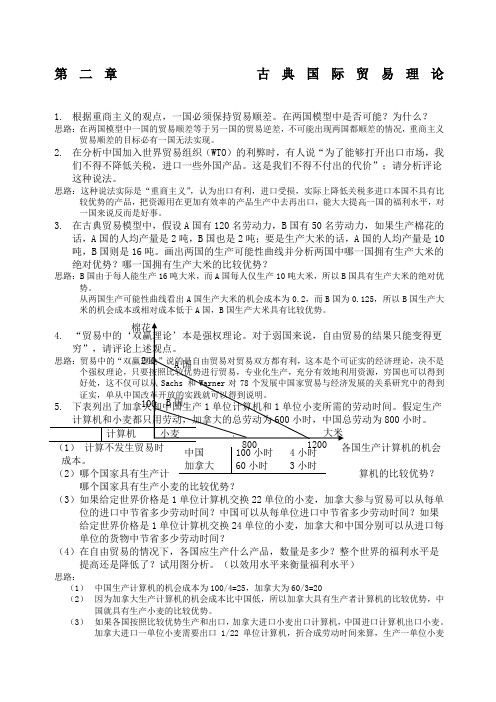
第二章 古典国际贸易理论1. 根据重商主义的观点,一国必须保持贸易顺差。
在两国模型中是否可能?为什么? 思路:在两国模型中一国的贸易顺差等于另一国的贸易逆差,不可能出现两国都顺差的情况,重商主义贸易顺差的目标必有一国无法实现。
2. 在分析中国加入世界贸易组织(WTO )的利弊时,有人说“为了能够打开出口市场,我们不得不降低关税,进口一些外国产品。
这是我们不得不付出的代价”;请分析评论这种说法。
思路:这种说法实际是“重商主义”,认为出口有利,进口受损,实际上降低关税多进口本国不具有比较优势的产品,把资源用在更加有效率的产品生产中去再出口,能大大提高一国的福利水平,对一国来说反而是好事。
3. 在古典贸易模型中,假设A 国有120名劳动力,B 国有50名劳动力,如果生产棉花的话,A 国的人均产量是2吨,B 国也是2吨;要是生产大米的话,A 国的人均产量是10吨,B 国则是16吨。
画出两国的生产可能性曲线并分析两国中哪一国拥有生产大米的绝对优势?哪一国拥有生产大米的比较优势?思路:B 国由于每人能生产16吨大米,而A 国每人仅生产10吨大米,所以B 国具有生产大米的绝对优势。
从两国生产可能性曲线看出A 国生产大米的机会成本为0.2,而B 国为0.125,所以B 国生产大米的机会成本或相对成本低于A 国,B 国生产大米具有比较优势。
800小时。
成本。
(2)哪个国家具有生产计算机的比较优势?哪个国家具有生产小麦的比较优势?(3)如果给定世界价格是1单位计算机交换22单位的小麦,加拿大参与贸易可以从每单位的进口中节省多少劳动时间?中国可以从每单位进口中节省多少劳动时间?如果给定世界价格是1单位计算机交换24单位的小麦,加拿大和中国分别可以从进口每单位的货物中节省多少劳动时间?(4)在自由贸易的情况下,各国应生产什么产品,数量是多少?整个世界的福利水平是提高还是降低了?试用图分析。
(以效用水平来衡量福利水平) 思路:(1) 中国生产计算机的机会成本为100/4=25,加拿大为60/3=20(2) 因为加拿大生产计算机的机会成本比中国低,所以加拿大具有生产者计算机的比较优势,中国就具有生产小麦的比较优势。
国际经济学课后练习与答案
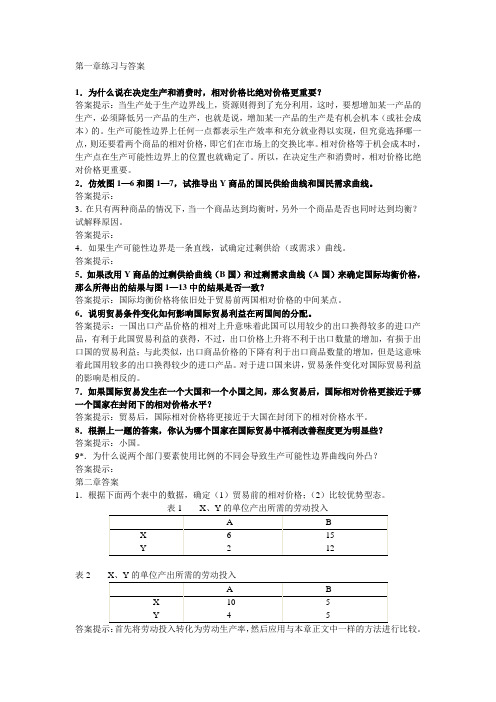
第一章练习与答案1.为什么说在决定生产和消费时,相对价格比绝对价格更重要?答案提示:当生产处于生产边界线上,资源则得到了充分利用,这时,要想增加某一产品的生产,必须降低另一产品的生产,也就是说,增加某一产品的生产是有机会机本(或社会成本)的。
生产可能性边界上任何一点都表示生产效率和充分就业得以实现,但究竟选择哪一点,则还要看两个商品的相对价格,即它们在市场上的交换比率。
相对价格等于机会成本时,生产点在生产可能性边界上的位置也就确定了。
所以,在决定生产和消费时,相对价格比绝对价格更重要。
2.仿效图1—6和图1—7,试推导出Y商品的国民供给曲线和国民需求曲线。
答案提示:3.在只有两种商品的情况下,当一个商品达到均衡时,另外一个商品是否也同时达到均衡?试解释原因。
答案提示:4.如果生产可能性边界是一条直线,试确定过剩供给(或需求)曲线。
答案提示:5.如果改用Y商品的过剩供给曲线(B国)和过剩需求曲线(A国)来确定国际均衡价格,那么所得出的结果与图1—13中的结果是否一致?答案提示:国际均衡价格将依旧处于贸易前两国相对价格的中间某点。
6.说明贸易条件变化如何影响国际贸易利益在两国间的分配。
答案提示:一国出口产品价格的相对上升意味着此国可以用较少的出口换得较多的进口产品,有利于此国贸易利益的获得,不过,出口价格上升将不利于出口数量的增加,有损于出口国的贸易利益;与此类似,出口商品价格的下降有利于出口商品数量的增加,但是这意味着此国用较多的出口换得较少的进口产品。
对于进口国来讲,贸易条件变化对国际贸易利益的影响是相反的。
7.如果国际贸易发生在一个大国和一个小国之间,那么贸易后,国际相对价格更接近于哪一个国家在封闭下的相对价格水平?答案提示:贸易后,国际相对价格将更接近于大国在封闭下的相对价格水平。
8.根据上一题的答案,你认为哪个国家在国际贸易中福利改善程度更为明显些?答案提示:小国。
9*.为什么说两个部门要素使用比例的不同会导致生产可能性边界曲线向外凸?答案提示:第二章答案1.根据下面两个表中的数据,确定(1)贸易前的相对价格;(2)比较优势型态。
国际经济学(克鲁格曼)课后习题答案1-8章
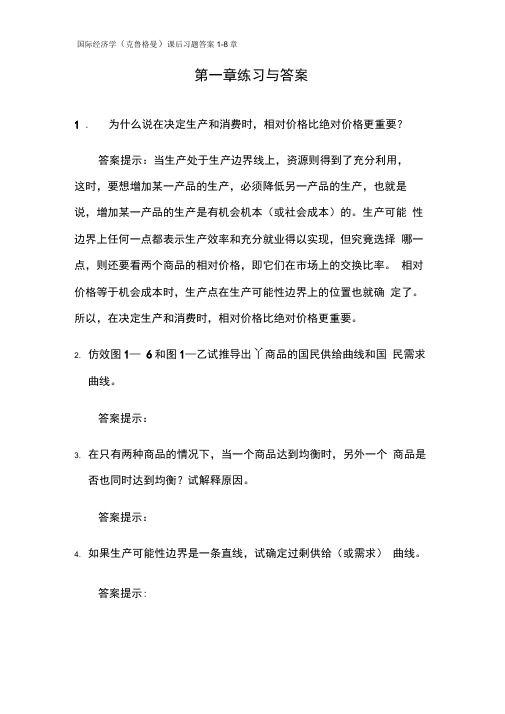
第一章练习与答案1 . 为什么说在决定生产和消费时,相对价格比绝对价格更重要?答案提示:当生产处于生产边界线上,资源则得到了充分利用,这时,要想增加某一产品的生产,必须降低另一产品的生产,也就是说,增加某一产品的生产是有机会机本(或社会成本)的。
生产可能性边界上任何一点都表示生产效率和充分就业得以实现,但究竟选择哪一点,则还要看两个商品的相对价格,即它们在市场上的交换比率。
相对价格等于机会成本时,生产点在生产可能性边界上的位置也就确定了。
所以,在决定生产和消费时,相对价格比绝对价格更重要。
2. 仿效图1—6和图1—乙试推导出丫商品的国民供给曲线和国民需求曲线。
答案提示:3. 在只有两种商品的情况下,当一个商品达到均衡时,另外一个商品是否也同时达到均衡?试解释原因。
答案提示:4. 如果生产可能性边界是一条直线,试确定过剩供给(或需求)曲线。
答案提示:5. 如果改用丫商品的过剩供给曲线(B国)和过剩需求曲线(A 国)来确定国际均衡价格,那么所得出的结果与图1 —13中的结果是否一致?答案提示:国际均衡价格将依旧处于贸易前两国相对价格的中间某点。
6. 说明贸易条件变化如何影响国际贸易利益在两国间的分配。
答案提示:一国出口产品价格的相对上升意味着此国可以用较少的出口换得较多的进口产品,有利于此国贸易利益的获得,不过,出口价格上升将不利于出口数量的增加,有损于出口国的贸易利益;与此类似,出口商品价格的下降有利于出口商品数量的增加,但是这意味着此国用较多的出口换得较少的进口产品。
对于进口国来讲,贸易条件变化对国际贸易利益的影响是相反的。
7. 如果国际贸易发生在一个大国和一个小国之间,那么贸易后,国际相对价格更接近于哪一个国家在封闭下的相对价格水平?答案提示:贸易后,国际相对价格将更接近于大国在封闭下的相对价格水平。
& 根据上一题的答案,你认为哪个国家在国际贸易中福利改善程度更为明显些?答案提示:小国9* .为什么说两个部门要素使用比例的不同会导致生产可能性边界曲线向外凸?答案提示:第二章答案1.根据下面两个表中的数据,确定(1)贸易前的相对价格;(2)比较优势型态。
国际经济学(克鲁格曼)课后习题答案1-8章
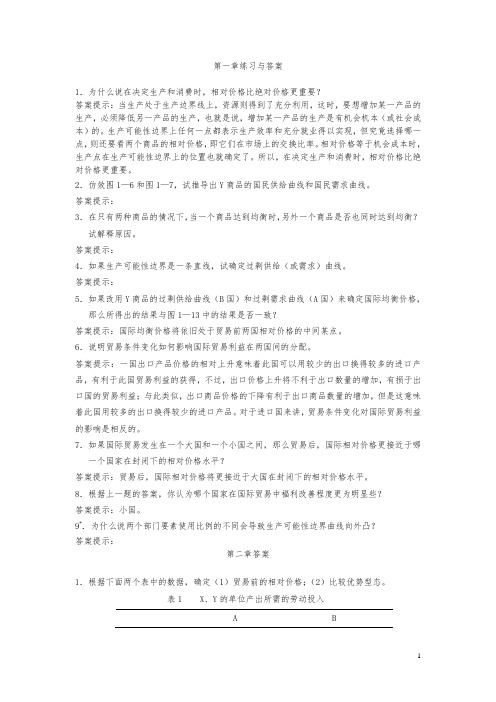
第一章练习与答案1.为什么说在决定生产和消费时,相对价格比绝对价格更重要?答案提示:当生产处于生产边界线上,资源则得到了充分利用,这时,要想增加某一产品的生产,必须降低另一产品的生产,也就是说,增加某一产品的生产是有机会机本(或社会成本)的。
生产可能性边界上任何一点都表示生产效率和充分就业得以实现,但究竟选择哪一点,则还要看两个商品的相对价格,即它们在市场上的交换比率。
相对价格等于机会成本时,生产点在生产可能性边界上的位置也就确定了。
所以,在决定生产和消费时,相对价格比绝对价格更重要。
2.仿效图1—6和图1—7,试推导出Y商品的国民供给曲线和国民需求曲线。
答案提示:3.在只有两种商品的情况下,当一个商品达到均衡时,另外一个商品是否也同时达到均衡?试解释原因。
答案提示:4.如果生产可能性边界是一条直线,试确定过剩供给(或需求)曲线。
答案提示:5.如果改用Y商品的过剩供给曲线(B国)和过剩需求曲线(A国)来确定国际均衡价格,那么所得出的结果与图1—13中的结果是否一致?答案提示:国际均衡价格将依旧处于贸易前两国相对价格的中间某点。
6.说明贸易条件变化如何影响国际贸易利益在两国间的分配。
答案提示:一国出口产品价格的相对上升意味着此国可以用较少的出口换得较多的进口产品,有利于此国贸易利益的获得,不过,出口价格上升将不利于出口数量的增加,有损于出口国的贸易利益;与此类似,出口商品价格的下降有利于出口商品数量的增加,但是这意味着此国用较多的出口换得较少的进口产品。
对于进口国来讲,贸易条件变化对国际贸易利益的影响是相反的。
7.如果国际贸易发生在一个大国和一个小国之间,那么贸易后,国际相对价格更接近于哪一个国家在封闭下的相对价格水平?答案提示:贸易后,国际相对价格将更接近于大国在封闭下的相对价格水平。
8.根据上一题的答案,你认为哪个国家在国际贸易中福利改善程度更为明显些?答案提示:小国。
9*.为什么说两个部门要素使用比例的不同会导致生产可能性边界曲线向外凸?答案提示:第二章答案1.根据下面两个表中的数据,确定(1)贸易前的相对价格;(2)比较优势型态。
国际经济学课后习题答案

第二章 古典国际贸易理论1. 根据重商主义的观点,一国必须保持贸易顺差。
在两国模型中是否可能?为什么? 思路:在两国模型中一国的贸易顺差等于另一国的贸易逆差,不可能出现两国都顺差的情况,重商主义贸易顺差的目标必有一国无法实现。
2. 在分析中国加入世界贸易组织(WTO )的利弊时,有人说“为了能够打开出口市场,我们不得不降低关税,进口一些外国产品。
这是我们不得不付出的代价”;请分析评论这种说法。
思路:这种说法实际是“重商主义”,认为出口有利,进口受损,实际上降低关税多进口本国不具有比较优势的产品,把资源用在更加有效率的产品生产中去再出口,能大大提高一国的福利水平,对一国来说反而是好事。
3. 在古典贸易模型中,假设A 国有120名劳动力,B 国有50名劳动力,如果生产棉花的话,A 国的人均产量是2吨,B 国也是2吨;要是生产大米的话,A 国的人均产量是10吨,B 国则是16吨。
画出两国的生产可能性曲线并分析两国中哪一国拥有生产大米的绝对优势?哪一国拥有生产大米的比较优势?思路:B 国由于每人能生产16吨大米,而A 国每人仅生产10吨大米,所以B 国具有生产大米的绝对优势。
从两国生产可能性曲线看出A 国生产大米的机会成本为0.2,而B 国为0.125,所以B 国生产大米的机会成本或相对成本低于A 国,B 国生产大米具有比较优势。
800小时。
成本。
(2)哪个国家具有生产计算机的比较优势?哪个国家具有生产小麦的比较优势?(3)如果给定世界价格是1单位计算机交换22单位的小麦,加拿大参与贸易可以从每单位的进口中节省多少劳动时间?中国可以从每单位进口中节省多少劳动时间?如果给定世界价格是1单位计算机交换24单位的小麦,加拿大和中国分别可以从进口每单位的货物中节省多少劳动时间?(4)在自由贸易的情况下,各国应生产什么产品,数量是多少?整个世界的福利水平是提高还是降低了?试用图分析。
(以效用水平来衡量福利水平) 思路:(1) 中国生产计算机的机会成本为100/4=25,加拿大为60/3=20(2) 因为加拿大生产计算机的机会成本比中国低,所以加拿大具有生产者计算机的比较优势,中国就具有生产小麦的比较优势。
国际经济学课后答案

第三章复习题(1),本国共有1200单位的劳动,能生产两种产品:苹果和香蕉。
苹果的单位产品劳动投入是3,香蕉的单位劳动产品投入时2。
a.画出本国的生产可能性边界。
b.用香蕉衡量的苹果的机会成本是多少?c.贸易前,苹果对香蕉的相对价格是多少?为什么?答:a.本国的生产可能性边界曲线是一条直线,在400(1200/3)处与苹果轴相截,在600(1200/2)处与香蕉轴相截,如图2-7所示。
b.用香蕉衡量苹果的机会成本是3/2。
生产1单位苹果需要3单位的劳动,生产1单位香蕉需要2单位的劳动。
如果放弃1单位苹果的生产,这将释放出3单位的劳动。
这2单位的劳动可以被用来生产3/2单位的香蕉。
c.劳动的流动性可以使得各个部门的工资趋同,竞争可以使得商品的价格等于它们的生产成本。
这样,相对价格等于相对成本,而相对成本等于工资乘以苹果的单位劳动产品投入。
因为各个部门工资相等,所以价格比率等于单位产品劳动投入的比率,即生产苹果所需的3单位劳动与生产香蕉所需的2单位劳动比率。
(2)假设本国的情况和习题1相同。
外国拥有800单位的劳动,外国苹果的单位劳动投入是5,香蕉的单位产品劳动投入是1。
a.画出外国的生产可能性边界。
b.画出世界相对供给曲线。
答:a.外国的生产可能性边界曲线是一条直线,在160(800/5)处与苹果轴相截,在800(800/1)处与香蕉轴相截。
如图2-8所示。
b.世界相对供给曲线可以由苹果和香蕉的相对价格和相对供给量绘出。
如图2-9。
图2-8 外国生产可能曲图2-9 世界相对供从图2-9可以看出,苹果对香蕉的最低相对价格是3/2,在这个价格上,苹果的世界相对供给曲线是水平的。
在3/2的相对价格上,本国对苹果的最大供给量是400,外国对香蕉的供给量是800,这时,相对供给量为1/2。
只要相对价格保持在3/2和5之间,相对供给量就不变。
如果相对价格成为5,两个国家都会生产苹果,香蕉的产量为零。
这时,相对供给曲线是水平的。
- 1、下载文档前请自行甄别文档内容的完整性,平台不提供额外的编辑、内容补充、找答案等附加服务。
- 2、"仅部分预览"的文档,不可在线预览部分如存在完整性等问题,可反馈申请退款(可完整预览的文档不适用该条件!)。
- 3、如文档侵犯您的权益,请联系客服反馈,我们会尽快为您处理(人工客服工作时间:9:00-18:30)。
第三章)Answers to End-of-Chapter Questions1. Use the information in the table on labor productivities in France and Germany toanswer the following questions.使用该信息表上关于法国和德国的劳动生产率,以回答以下问题。
Output per Hour Worked单位工作小时的产出France GermanyCheese 2 kilograms 1 kilogramCars 0.25 0.5a. Which country has an absolute advantage in cheese? In cars?哪个国家有奶酪的绝对优势?汽车呢?b. What is the relative price of cheese in France if it does not trade? In Germany, if itdoes not trade?什么是奶酪在法国的相对价格,如果它不交易?在德国,如果不进行交易?c. What is opportunity cost of cheese in France? In Germany?法国奶酪的机会成本是多少?德国呢?d. Which country has a comparative advantage in cheese? In cars? Show how youknow.在奶酪生产上,那个国家有比较优势?在汽车生产上呢?解释你的结论e. What are the upper and lower bounds for the trade price of cheese?奶酪交易价格的上下边界是什么?f.Draw a hypothetical PPC for France and label its slope. Suppose that France followsits comparative advantage in deciding where to produce on its PPC. Label itsproduction point.画一条假设的法国生产可能性曲线并标出其斜率。
假设法国根据其比较优势决定生产可能性曲线上生产点,标出其生产点。
If the trade price of cars is 5 kilos of cheese per car, draw a trade line showing howFrance can gain from trade.如果贸易价格是每辆汽车换5千克奶酪,画出交易线说明法国能够得到的贸易利得。
Answers:a. France has the absolute advantage in cheese and Germany in cars. This followsbecause France’s productivity is higher in cheese and Germany’s is higher in cars.法国有干酪和德国车的绝对优势。
在此之前,因为法国的生产力是奶酪更高,德国是汽车高b. The autarkic relative price of cheese in France is one-eighth car per kilogram; inGermany it is one-half car.奶酪在法国的自给自足的相对价格是每公斤八分之一的汽车;在德国它是二分之一的汽车c. Opportunity costs are equal to relative prices.机会成本等于相对价格d. France has a comparative advantage in cheese because its opportunity cost is lower (one-eighth car versus one-half car in Germany). By the same reasoning, Germany has a comparative advantage in cars.法国有比较优势的奶酪,因为它的机会成本较低(八分之一的车与二分之一的汽车在德国)。
同样的道理,德国在汽车的比较优势。
e. The trade price of cheese will settle between one-eighth and one-half car per kilo.奶酪的贸易价格将位于每千克八分之一到二分之一辆汽车之间f.2. Suppose the table in Problem 1 looks like the following instead:假设问题1中的表格为下表所代替Output per Hour WorkedFrance GermanyCheese 1 kilogram 2 kilogramsCars 0.25 2Answer questions (a)–(e) from Problem 1. For Part (f), assume the nations trade at 1 car for 2 cheese.回答1题中的1-5问题。
假设国际交易是一辆汽车换2块奶酪,回答第6问题Answers:a. Germany has an absolute advantage in both cheese and cars.德国都具有绝对优势b. 1 cheese = 0.25 car in France; 1 cheese =1 car in Germanyc. same as Part (b).同上d. France has a comparative advantage in cheese because its opportunity cost in terms of cars is lower (0.25 car vs. 1 car); Germany has a comparative advantage in car production (1 cheese vs. 4 cheese).法国有比较优势的奶酪,因为其机会成本的汽车而言是较低(0.25车与1辆);德国在汽车生产(1奶酪与奶酪4 )具有相对优势。
e. The trade price of cheese will settle between 0.25 car and 1 car.f.3. Explain how a nation can gain from trade even though not everyone is made better off.Isn’t this a contradiction?Answer: This is not a contradiction. The gains from trade imply that the winners could compensate the losers completely and still have gains left over. Some peoplemay lose jobs (in the example in the text, as the United States moved towardspecialization in steel, American workers were shifted out of the breadindustry and into the steel industry), but others benefit from the higherdemand for their product (workers in the steel industry). As long as thewinner’s gains are greater than the loser’s losses, we can conclude that thenation wins.这不是一个矛盾。
从贸易的收益意味着获奖者可以完全补偿失败者,仍然有剩下的收益。
有些人可能会失去工作(在本例中的文本,如美国钢铁走向专业化,美国工人被转移出来的面包行业,进入钢铁行业),但对他们的产品需求上升他人受益(工人在钢铁行业)。
只要获奖者的收益是大于失败者的损失,我们可以得出结论,国家赢了。
4. Economic nationalists in developed countries worry that international trade is destroyingthe national economy. A common complaint is that trade agreements open the economy to increased trade with countries where workers are paid a fraction of what they earn at home. Explain the faulty logic of this argument.Answer:The error in logic is the failure to take into account the differences inproductivity. The low-wage workers in less developed countries in generalare paid less because they produce less output during each hour of labor.Furthermore, the developed nations andthe less developed nations are not in competition for economic growth.Growth in one country benefits the other through an increase in the demandfor its products. Economic nationalists tend to view trade as a zero-sum gamein which one side loses and theother wins.在逻辑错误是未能考虑到生产率的差异。
低工资的工人在欠发达国家,一般是因为他们的劳动力的每一个小时内产生较少的输出的薪水。
